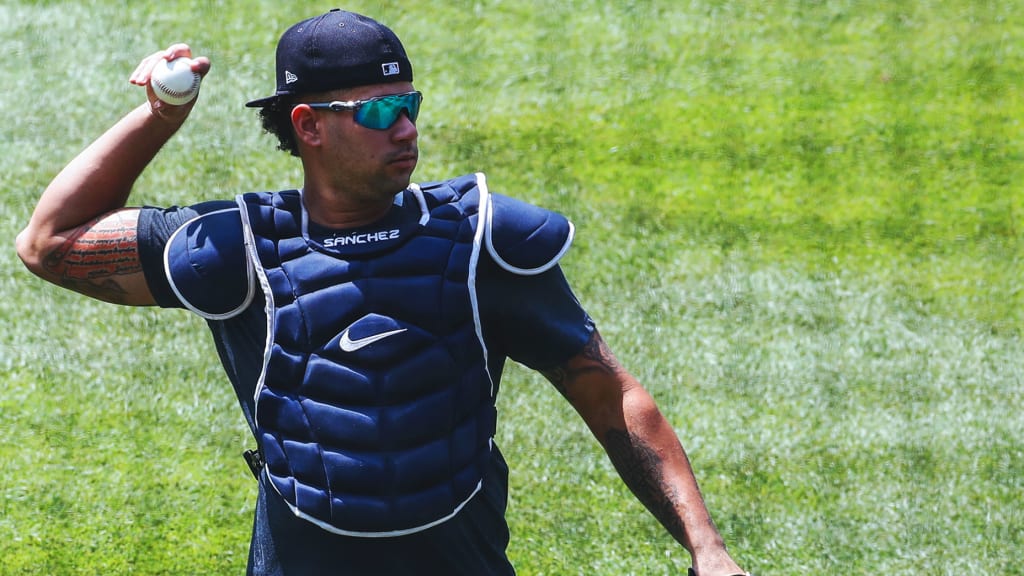
Gary Sánchez isn't hitting, even a little. While 37 plate appearances aren't exactly enough to tell you anything about anything, a line of .091/.189/.212 and a 51% strikeout rate -- no, really -- does at least tell you that he's not exactly helping the Yankees lineup right now, even with a homer on Thursday night.
He'll be fine, of course. Last July, he hit .102/.172/.186. In June 2018, he hit .121/.215/.259. You're noticing this one a little more because it's at the start of a season, but he goes through these things all the time, and he'll most likely still end up being one of the best hitting catchers in the game by the time the season gets to the finish line. So instead of focusing on that, let's point out the thing he's worked very hard on that seems to have really improved. Let's talk about his pitch framing.
If it seems like we talk about Sánchez's defensive liabilities every year, well, we do. Whether it's framing or blocking, it's an annual story; here it is in 2017, and 2018, and 2019. No one doubts his cannon of a right arm, but no one over 2016-'19 had more passed balls than his 47, and, if we can borrow a graph made by Jay Jaffe for FanGraphs back in February, Sánchez's framing wasn't exactly stellar either.
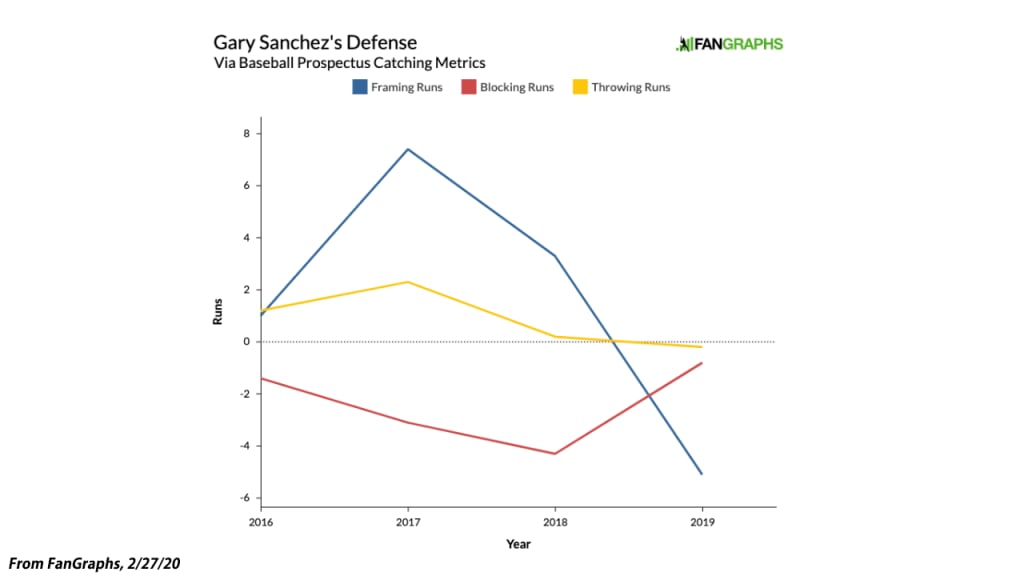
That was especially true along the bottom edge of the strike zone, where Sánchez turned only 42% of takes into called strikes last year. That was well below the Major League average of 50%; it ranked 56th of 64 qualifying catchers.
It's not like Sánchez and the Yankees didn't know that, obviously. One of the bigger moves the team made this winter -- not as big as signing Gerrit Cole, obviously, but big nonetheless -- was hiring Tanner Swanson away from the Twins to serve as catching coach. In 2019, Swanson received a lion's share of the credit for helping Minnesota catcher Mitch Garver improve from one of baseball's weakest framers into a much more valuable receiver. That was especially true low, where Garver had a 34% called-strike rate in 2018, before turning that into 58% in 2019 and 56% so far this year.
("It’s the only reason I’m still catching," Garver told FiveThirtyEight. "Really.")
And so, a million stories about that were written this winter, most focusing on how Swanson was helping Sánchez -- as he did Garver -- by teaching him to receive with one knee on the ground in all situations, rather than the traditional equal crouch on both feet.
“If you get into a lower position where you can control the bottom of the zone, you handle more pitches with depth,” Swanson told MLB.com's Bryan Hoch in February. “That's where a majority of borderline pitches live, and it’s probably the part of the zone that can be exploited from a framing standpoint. We all know what Gary can do with his arm, so it's mostly the receiving and the blocking -- trying to clean that up and find a position that allows him to do a lot of those things at a high level.”
You can see exactly what that looks like here, comparing 2019 to 2020 but otherwise in identical situations -- each at home, with James Paxton on the mound facing a right-handed Red Sox hitter, and with a runner on first base in a 0-0 count.
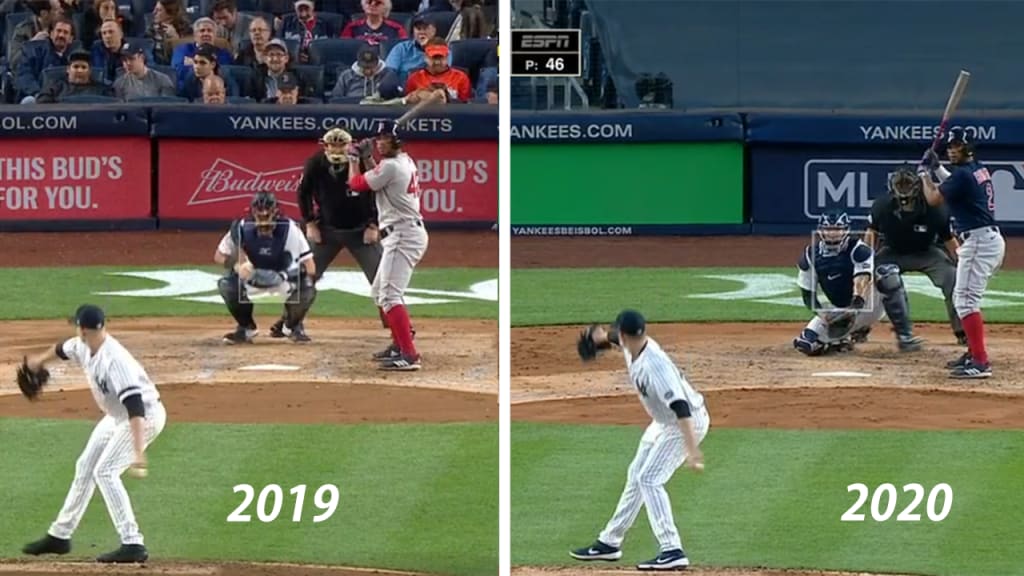
This July, after months of work, Sánchez told Hoch that he thought the effort was paying off, saying that "I definitely feel the improvement. I want to say that I definitely have gotten better, especially with pitches low in the zone."
It's early in the season, of course. But so far ... he has improved, by a lot. As we said above, Sánchez has generally been among the least effective receivers of pitches on the bottom edge of the zone. This year? He's among the best (and, in an extremely small sample, New York's backup backstop Kyle Higashioka is at the top.)
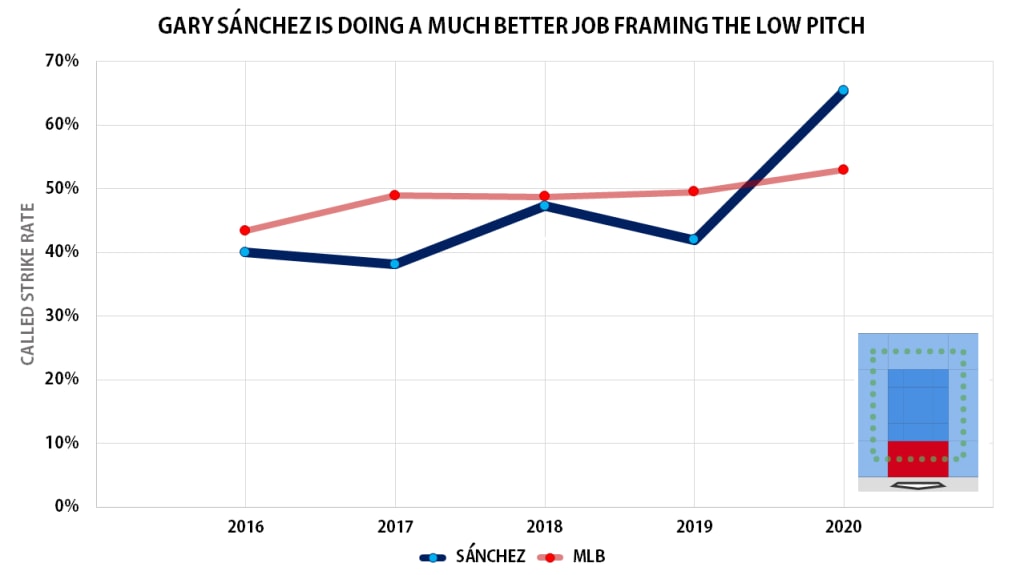
We can show you exactly what that looks like. On Aug. 3, Sánchez helped Gerrit Cole strike out J.T. Realmuto on a low pitch, and while you might watch this and argue whether or not it was actually a strike, that's entirely the point. A year ago, Sánchez would have been unlikely to turn this into an out.
Here he is on Aug. 1, hanging onto a breaking ball from rookie Nick Nelson for a called third strike against Xander Bogaerts.
Last year, the Yankees as a team were 17th in called strike rate, across any location. This year, they're 12th. If you're wondering how much this matters, each extra strike is worth about .125 runs, and since the rule of thumb is that 10 runs roughly equals 1 Win Above Replacement, you can see why the spread between Austin Hedges' +15 and James McCann's minus-15 last year -- that's 30! -- is so important. Or, put another way, think about how the first pitch of a plate appearance can make a huge difference. After 0-1 last year, the Majors had a .631 OPS. After 1-0, it was .858, a 227-point difference.
All of which is a long way of saying: Even if Sánchez isn't hitting (yet), he's now got a new way of benefiting the Yankees. While it's obviously still early, it's easier to feel confident in small sample numbers when it's reflecting something that was very clearly worked on all winter long.
Now, it's worth noting: This is not just about Sánchez. While he might be our poster boy today, because he's a big name on a popular team, if you go back to the chart we had above, remove him, and zoom in a little, look what's happened low in the zone across the league:
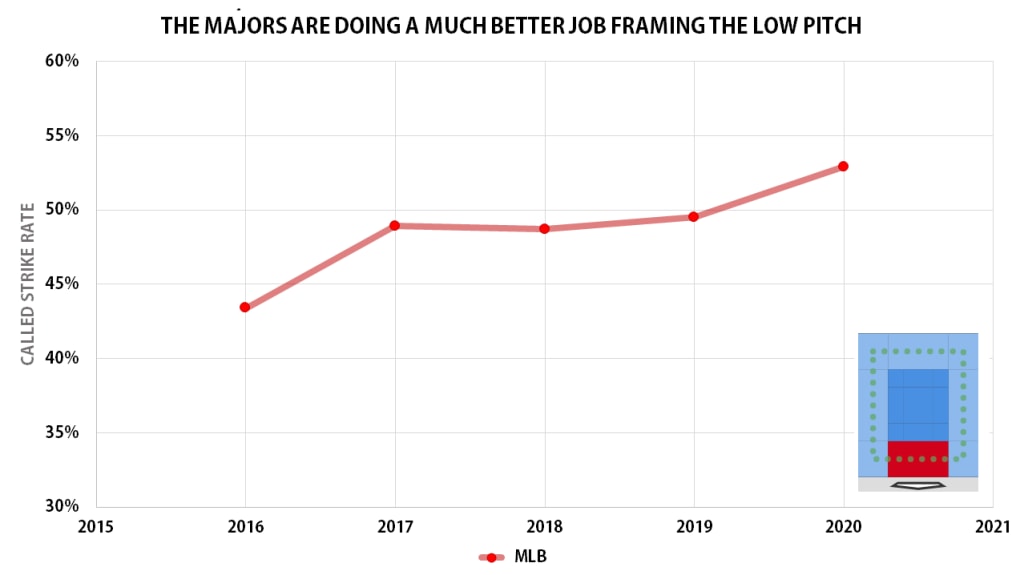
That's also true, to some extent, around all the edges of the zone, but let's focus on the low zone for a moment. Just in that area alone, there is growth of more than 1,000 extra called strikes from 2016 to '19. That's partially because poor framers just don't get to stick behind the plate these days, and it's partially because framing seems like a skill that can be improved, and because catching coaches like Swanson are doing such a great job of helping catchers learn how to do it.
(There's also, it's worth noting, many more pitches on the lower edge of the zone. In 2008, there were 25,095 pitches that didn't get a swing in that area. In 2019, it was 28,805. That's a pretty large jump.)
That's because the examples of improvement are plentiful. In addition to Garver and Sánchez, the Phillies helped J.T. Realmuto go from minus-11 runs in 2016 for Miami to +7 runs with the Phillies last year. That was partially due to catching coach Craig Driver, who joined the Cubs this past winter with a goal of helping Willson Contreras improve from last year's dreadful showing. So far, his called-strike rate at the bottom of the zone has improved from 48% to 56%. Meanwhile, Jorge Alfaro, who was traded for Realmuto, was +9 with Driver in Philadelphia in '18, and minus-6 in Miami without him in '19.
As far as Sánchez goes, don't worry about the poor hitting line. He'll hit. He always hits. Pay more attention to what's happening behind the plate. It's different, and it's real, and it's important. For maybe the first time, he's adding some real value on the field even when the bat is cold.
